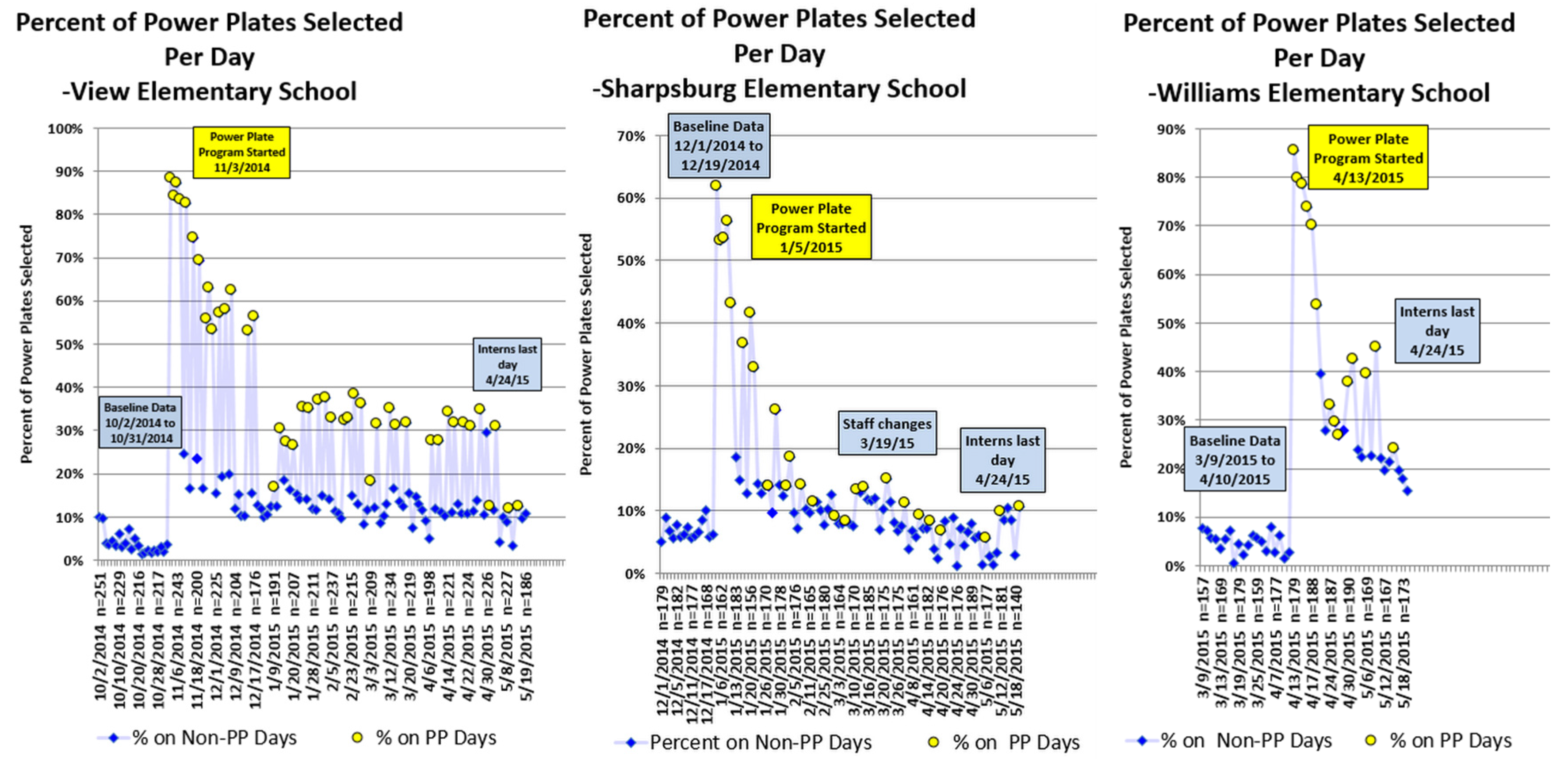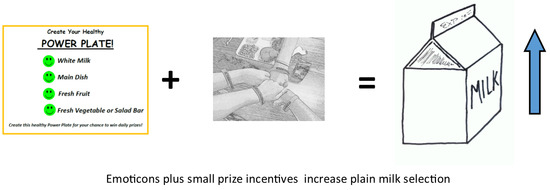Small Prizes Increased Plain Milk and Vegetable Selection by Elementary School Children without Adversely Affecting Total Milk Purchase
Abstract
:1. Introduction
2. Materials and Methods
3. Results
4. Discussion
5. Conclusions
Acknowledgments
Author Contributions
Conflicts of Interest
References
- Ng, M.; Fleming, T.; Robinson, M.; Thomson, B.; Graetz, N.; Margono, C.; Mullany, E.C.; Biryukov, S.; Abbafati, C.; Abera, S.F.; et al. Global, regional, and national prevalence of overweight and obesity in children and adults during 1980–2013: A systematic analysis for the Global Burden of Disease Study 2013. Lancet 2014, 384, 766–781. [Google Scholar] [CrossRef]
- Ogden, C.L.; Carroll, M.D.; Kit, B.K.; Flegal, K.M. Prevalence of childhood and adult obesity in the United States, 2011–2012. JAMA 2014, 311, 806–814. [Google Scholar] [CrossRef] [PubMed]
- Finkelstein, D.M.; Hill, E.L.; Whitaker, R.C. School food environments and policies in US public schools. Pediatrics 2008, 122, e251–e259. [Google Scholar] [CrossRef] [PubMed]
- Zheng, M.; Rangan, A.; Allman-Farinelli, M.; Rohde, J.F.; Olsen, N.J.; Heitmann, B.L. Replacing sugary drinks with milk is inversely associated with weight gain among young obesity-predisposed children. Br. J. Nutr. 2015, 114, 1448–1455. [Google Scholar] [CrossRef] [PubMed]
- Hutchins, E. Flavored Milk and the National School Lunch Program. Available online: http://uknowledge.uky.edu/cph_etds/23 (accessed on 11 October 2016).
- French, S.A.; Stables, G. Environmental Interventions to Promote Vegetable and Fruit Consumption Among Youth in School Settings. Prev. Med. 2003, 37, 593–610. [Google Scholar] [CrossRef] [PubMed]
- Hanks, A.S.; Just, D.R.; Smith, L.E.; Wansink, B. Healthy convenience: Nudging students toward healthier choices in the lunchroom. J. Pub. Health 2012, 34, 370–376. [Google Scholar] [CrossRef] [PubMed]
- Privitera, G.J.; Taylor, E.P.; Misenheimer, M.; Paque, R. The effectiveness of “emolabeling” to promote healthy food choices in children preschool through 5th grade. Int. J. Child. Health Nutr. 2014, 3, 48–54. [Google Scholar] [CrossRef]
- Cawley, J.; Price, J.A. A case study of a workplace wellness program that offers financial incentives for weight loss. J. Health Econ. 2013, 32, 794–803. [Google Scholar] [CrossRef] [PubMed]
- Volpp, K.G.; Troxel, A.B.; Pauly, M.V.; Glick, H.A.; Puig, A.; Asch, D.A.; Galvin, R.; Zhu, J.; Wan, F.; DeGuzman, J.; Corbett, E. A randomized, controlled trial of financial incentives for smoking cessation. N. Engl. J. Med. 2009, 360, 699–709. [Google Scholar] [CrossRef] [PubMed]
- Baicker, K.; Cutler, D.; Song, Z. Workplace wellness programs can generate savings. Health Aff. (Millwood) 2010, 29, 304–311. [Google Scholar] [CrossRef] [PubMed]
- Brownell, K.; Horgen, K. Food Fight: The Inside Story of the Food Industry, America’s Obesity Crisis, and What We Can Do About It; Contemporary Books: Chicago, IL, USA, 2004. [Google Scholar]
- Hobin, E.P.; Hammond, D.G.; Daniel, S.; Hanning, R.; Manske, S.R. The Happy Meal® effect: The impact of toy premiums on healthy eating among children in Ontario, Canada. Can. J. Public Health 2012, 103, e244–e248. [Google Scholar] [PubMed]
- Just, D.R.; Price, J. Using incentives to encourage healthy eating in children. J. Human Resour. 2013, 48, 855–872. [Google Scholar] [CrossRef]
- List, J.A.; Samek, A.S. The behavioralist as nutritionist: Leveraging behavioral economics to improve child food choice and consumption. J. Health Econ. 2015, 39, 135–146. [Google Scholar] [CrossRef] [PubMed]
- List, J.A.; Samek, A. A field experiment on the impact of incentives on milk choice in the lunchroom. Public Finan. Rev. 2015, 45, 44–67. [Google Scholar] [CrossRef]
- Siegel, R.M.; Anneken, A.; Duffy, C.; Simmons, K.; Hudgens, M.; Lockhart, M.K.; Shelly, J. Emoticon use increases plain milk and vegetable purchase in a school cafeteria without adversely affecting total milk purchase. Clin. Ther. 2015, 37, 1938–1943. [Google Scholar] [CrossRef] [PubMed]
- Siegel, R.M.; Hudgens, H.; Annekin, A.; Simmons, K.; Shelly, J.; Bell, I.; Kotagal, U.R. A Two-Tiered School Cafeteria Intervention of Emoticons and Small Prizes Increased Healthful Food Selection. IJFANS. 2016, 5. Available online: http://www.ijfans.com/ijfansadmin/upload/ijfans_5784ca415b87a.pdf (accessed on 12 October 2016).
- Barnes, A.S.; Hudgens, M.E.; Ellsworth, S.C.; Lockhart, M.K.; Shelley, J.; Siegel, R.M. Emoticons and Small Prizes to Improve Food Selection in an Elementary School Cafeteria: A 15 Month Experience. J. Pediatr. Child Nutr. 2016, 2, 100108. [Google Scholar]
- Hudgens, M.; Barnes, A.; Lockhart, M.K.; Ellsworth, S.; Beckford, M.; Siegel, R. Small Prizes Improve Food Selection in a School Cafeteria without Increasing Waste. Clin. Pediatr. 2016. [Google Scholar] [CrossRef] [PubMed]
- Siegel, R.; Lockhart, M.K.; Barnes, A.S.; Hiller, E.; Kipp, R.; Robison, D.L.; Ellsworth, S.C.; Hudgens, M.E. Small prizes increased healthful school lunch selection in a Midwestern school district. Appl. Physiol. Nutr. Metab. 2014, 41, 370–374. [Google Scholar] [CrossRef] [PubMed]
- Norwood City School District. Available online: http://public-schools.startclass.com/d/d/Norwood-City-%28District%29 (accessed on 16 February 2017).
- Ellery, J. The nutritional importance of milk and milk products in the national diet. Int. J. Dairy Tech. 1978, 31, 179–181. [Google Scholar] [CrossRef]
- Fayet-Moore, F. Effect of flavored milk vs plain milk on total milk intake and nutrient provision in children. Nutr. Rev. 2016, 74, 1–7. [Google Scholar] [CrossRef] [PubMed]
- Quann, E.E.; Adams, D. Impact on milk consumption and nutrient intakes from eliminating flavored milk in elementary schools. Nutr. Today 2013, 48, 127–134. [Google Scholar] [CrossRef]
- Hanks, A.S.; Just, D.R.; Wansink, B. Chocolate milk consequences: A pilot study evaluating the consequences of banning chocolate milk in school cafeterias. PLoS ONE 2014, 9, e91022. [Google Scholar] [CrossRef] [PubMed]
- Birch, L.L.; Birch, D.; Marlin, D.W.; Kramer, L. Effects of Instrumental Eating on Children's Food Preferences. Appetite 1982, 3, 125–134. [Google Scholar] [CrossRef]
- Birch, L.L.; Marlin, D.W.; Rotter, J. Eating as the “means” activity in a contingency: Effects on young children's food preference. Child Dev. 1984, 55, 431–439. [Google Scholar] [CrossRef]


| School | Enrollment | %Black | %White | %Hispanic | %Girls | %Boys | %Low income * |
|---|---|---|---|---|---|---|---|
| Norwood View | 409 | 12.7 | 68.7 | 13.9 | 48 | 52 | 70.4 |
| Sharpsburg Elementary | 260 | 12.7 | 71.2 | 8.8 | 44 | 56 | 72.7 |
| Williams Avenue | 291 | 12.4 | 75.3 | 6.5 | 48 | 52 | 75.9 |
| All Schools Combined | 960 | 12.6 | 71.3 | 10.2 | 47 | 53 | 72.7 |
| Food Item | Rate Selected Per Student Pre-Incentives n = 13,506 lunches | 95% Confidence Interval | Rate Selected Per Student with Incentives n = 145,090 lunches | 95% Confidence Interval | p Value Comparing Pre to with Incentives |
|---|---|---|---|---|---|
| Power Plate * | 0.0522 | 0.05-0.06 | 0.194 | 0.19-0.20 | <0.0000001 |
| Plain milk * | 0.0984 | 0.09-0.11 | 0.255 | 0.25-0.26 | <0.0000001 |
| Chocolate milk * | 0.818 | 0.80-0.84 | 0.700 | 0.70-0.71 | <0.0000001 |
| Total (Chocolate + Plain) milk * | 0.916 | 0.90-0.94 | 0.956 | 0.95-0.96 | 0.000331 |
| Vegetables * | 1.299 | 1.27-1.32 | 1.416 | 1.41-1.42 | <0.0000001 |
| Fruits * | 0.667 | 0.65-0.69 | 0.790 | 0.79-0.80 | <0.0000001 |
© 2017 by the authors; licensee MDPI, Basel, Switzerland. This article is an open access article distributed under the terms and conditions of the Creative Commons Attribution (CC BY) license (http://creativecommons.org/licenses/by/4.0/).
Share and Cite
Emerson, M.; Hudgens, M.; Barnes, A.; Hiller, E.; Robison, D.; Kipp, R.; Bradshaw, U.; Siegel, R. Small Prizes Increased Plain Milk and Vegetable Selection by Elementary School Children without Adversely Affecting Total Milk Purchase. Beverages 2017, 3, 14. https://doi.org/10.3390/beverages3010014
Emerson M, Hudgens M, Barnes A, Hiller E, Robison D, Kipp R, Bradshaw U, Siegel R. Small Prizes Increased Plain Milk and Vegetable Selection by Elementary School Children without Adversely Affecting Total Milk Purchase. Beverages. 2017; 3(1):14. https://doi.org/10.3390/beverages3010014
Chicago/Turabian StyleEmerson, Megan, Michelle Hudgens, Allison Barnes, Elizabeth Hiller, Debora Robison, Roger Kipp, Ursula Bradshaw, and Robert Siegel. 2017. "Small Prizes Increased Plain Milk and Vegetable Selection by Elementary School Children without Adversely Affecting Total Milk Purchase" Beverages 3, no. 1: 14. https://doi.org/10.3390/beverages3010014
APA StyleEmerson, M., Hudgens, M., Barnes, A., Hiller, E., Robison, D., Kipp, R., Bradshaw, U., & Siegel, R. (2017). Small Prizes Increased Plain Milk and Vegetable Selection by Elementary School Children without Adversely Affecting Total Milk Purchase. Beverages, 3(1), 14. https://doi.org/10.3390/beverages3010014








